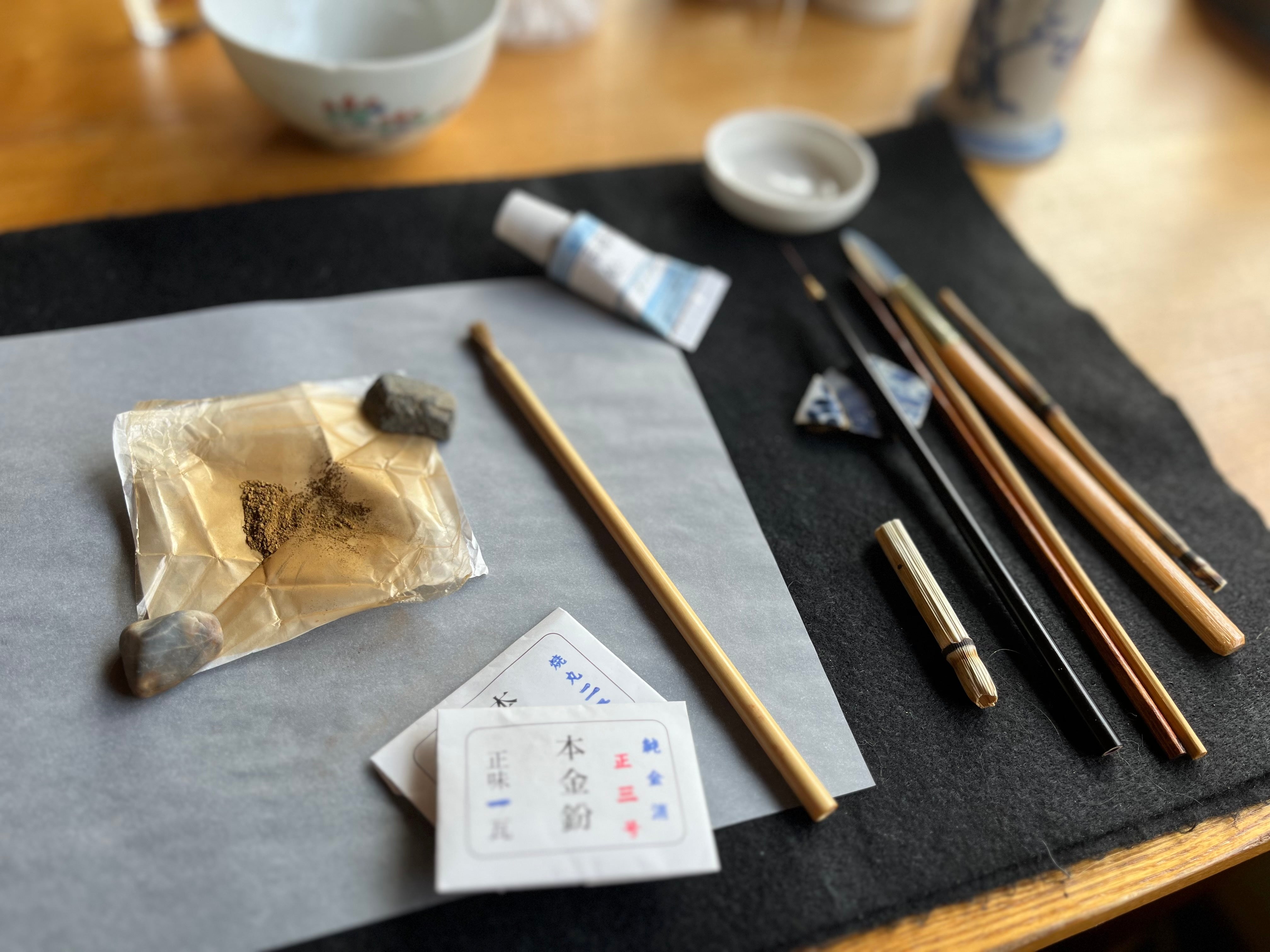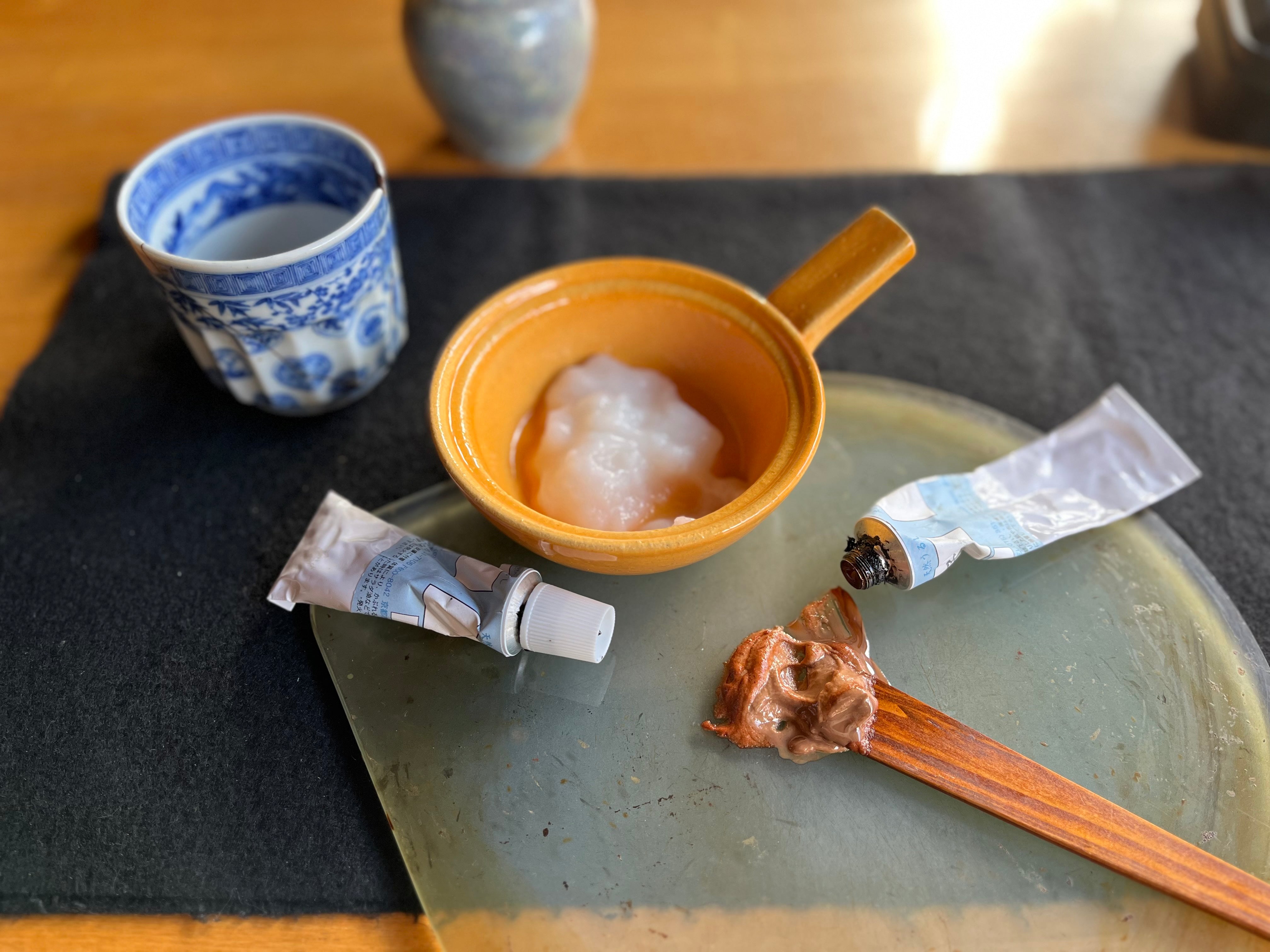04 December 2023
My Journey with Kintsugi


When I was a child, I lived next to a tea ceremony teacher. I remember first encountering kintsugi when I visited that house. Back then, Japan was experiencing rapid economic growth, and many people admired new technologies and the allure of brand-new items with a Western touch. My family was no exception, but I fondly remember feeling very comfortable in the neighboring traditional Japanese house, with its polished but old single-story structure, set in a spacious garden with a large tree.
To be honest, I can't recall the exact reason I started kintsugi. However, I think this childhood memory was the beginning of my interest.

Presenter
Kawamura Noriko
Kawamura Noriko specializes in Kintsugi with lacquer and natural materials. She founded the Fujimura House Urushi & Kintsugi Workshop in a 240-year-old Omi merchant house in Hino Town, Shiga, after learning lacquer repair.
Go to WebsiteContents
- About the Workshop
- What is Kintsugi?
- The History of Lacquer Repairs
- Supporting Japan's Architecture Through Lacquer Repair Work
- Mending Memories
About the Workshop

My home and workshop are located in Hino Town, Gamo District, Shiga Prefecture, a town known as the birthplace of the Omi merchants. The Omi Hino merchants, one of the groups of Omi merchants, began as peddlers of lacquered bowls during the Edo period and flourished in industries like pharmaceuticals and brewing.
About eight years ago, we came across a 240-year-old house, once inhabited by these merchants. We instantly fell in love with its meticulously preserved wood, the details crafted by skilled artisans, and the overall aura. We moved our residence and workplace from Tokyo and Aichi to this house. Although I had been practicing kintsugi for a while, I took this opportunity to relearn and apprentice under a lacquer restoration artisan in Kyoto.
A few years later, with the growing interest in kintsugi, my mentor suggested I set up my own workshop. We refurbished a building on the premises, I named it the "Fujimura House Urushi & Kintsugi Workshop" after receiving permission to use the name from Mr. Fujimura, the original owner, who still runs "Raifuku Brewery" in Ibaraki.
What is Kintsugi?

Kintsugi is often mistakenly believed to be repair work using gold, but actually it is a form of lacquer repair known as urushi-tsugi "lacquer mending." In traditional kintsugi, gold powder is sprinkled over lacquer repairs, similar to the maki-e method, but there are many different finishing techniques using other metal powders like silver, adding different ceramic pieces or other natural materials, or colored lacquers.
Recently, more modern and quicker methods using synthetic adhesives and imitation lacquers have become popular, often referred to as "modern kintsugi" or "easy kintsugi." Traditional lacquer repairs that only use natural materials are called hon-urushi-tsugi "true lacquer mending," hon-tsugi "true mending," or hon kintsugi "true kintsugi."
The History of Lacquer Repairs
In Japan, the history of human using lacquer to make repairs dates back to the Jomon period (Circa 14,000 BCE – 3rd to 5th centuries BCE). When a lacquer tree is damaged, it uses its sap to heal cracks and breaks, much like blood seals cuts and grazes. This quality made lacquer ideal for repairing ceramics. The decorative form of lacquer mending, kintsugi, emerged during the Muromachi period (1336 CE – 1573 CE) as part of the tea ceremony culture.
Instead of hiding defects, this technique celebrates them by creating a new landscape on the repaired item. This appreciation of imperfection and uncontrollable beauty is reflected not only in kintsugi, but also in Japanese gardens, architecture, and arts in general. The essence of Japan's aesthetic may be influenced by the mixed sense of fragility, resilience and permanence in Japan, a county prone to natural disasters. This interplay of fragility and strength, alongside the appreciation of tranquility and imperfection embodied in Wabi-Sabi, and the Zen spirituality of emptying oneself to transcend the boundaries between self and other, influences this sense of beauty.

While the visible charm of kintsugi is undeniable, I was also deeply drawn to the use of natural materials. Hon-tsugi "true mending" uses rice or wheat flour as an adhesive, and for fillers, a mixture of earth, wood powder, and lacquer are used. The tools are crafted from bamboo or wood, and plants or charcoal serve as sandpaper. It is meticulous and time-consuming work which may seem inefficient. However, I believe that using things that are close at hand and return to nature is important in many ways for myself, my family and our future world. And I find it calming to immerse myself in the seemingly tedious, detailed and time-intensive process. Many who initially start kintsugi for its glittering allure become engrossed in the sheer joy of the process. This, I believe, is one of its greatest attractions.
Supporting Japan's Architecture Through Lacquer Repair Work
Historical wooden structures in Japan, such as temples, shrines, and castles, have been preserved for centuries or even millennia using natural materials, including lacquer. As well as being decorative, lacquer, with its high waterproof, antifungal, and insect-repellent properties, protects both small items like bowls and the wood of these buildings. During restoration work, removing lacquer applied hundreds of years before often reveals completely unharmed materials beneath. Today's restorers are able to learn about the skills of the masters long ago, and apply them to their own techniques to protect the building for hundreds more years to come. In this sense, lacquer mending also serves to pass down precious heritages to future generations.
Mending Memories

Almost every repair commission comes with a story. It's not about the item's monetary value. Even if buying a new one might be cheaper and easier, the memories and sentiments attached to each item are irreplaceable. Above all, urushi-tsugi might be about preserving those memories and emotions. I believe this is its most profound allure.






















































































































































































































